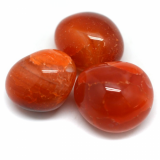Carnelian

Like many gemstones, carnelian possesses a number of different symbolic meanings.
Carnelian belongs to a family of gemstones known as chalcedony, which also includes agate, jasper, and bloodstone. All chalcedony stones are varieties of quartz, and they are labeled as chalcedony due to a specific type of physical structure; the grains and fibers in these stones are significantly smaller than in other types of quartz, which gives chalcedony stones their opaque or waxy appearance.
One of the simplest ways to distinguish members of the chalcedony family is by color. Carnelian is easily spotted by its distinctive red-orange hue, and this color is the main indicator of its symbolic meanings. Like other red-colored stones such as rubies and garnets, carnelian was once thought to have a strong medicinal connection to blood: It was believed that carnelian could stimulate the circulatory system and help to staunch bleeding wounds. To the ancient Egyptians, this association with blood took on a more metaphorical aspect; they referred to carnelian as the “blood of Isis”, and amulets carved from the stone were sometimes placed in sarcophagi to ensure that the dead had Isis’ protection in the next world.
Further positive medicinal effects were attributed to carnelian: It could enhance emotions such as happiness, self-confidence, and courage, and in powdered form it was believed to be an effective defense against poison. Anger could be cooled by carnelian, and it could also make dreams and desires come true.
Carnelian was one of the twelve stones set into the breastplate of the High Priest of ancient Israel, an object often cited as a possible originator of the modern concept of birthstones.
© Symbols.com
